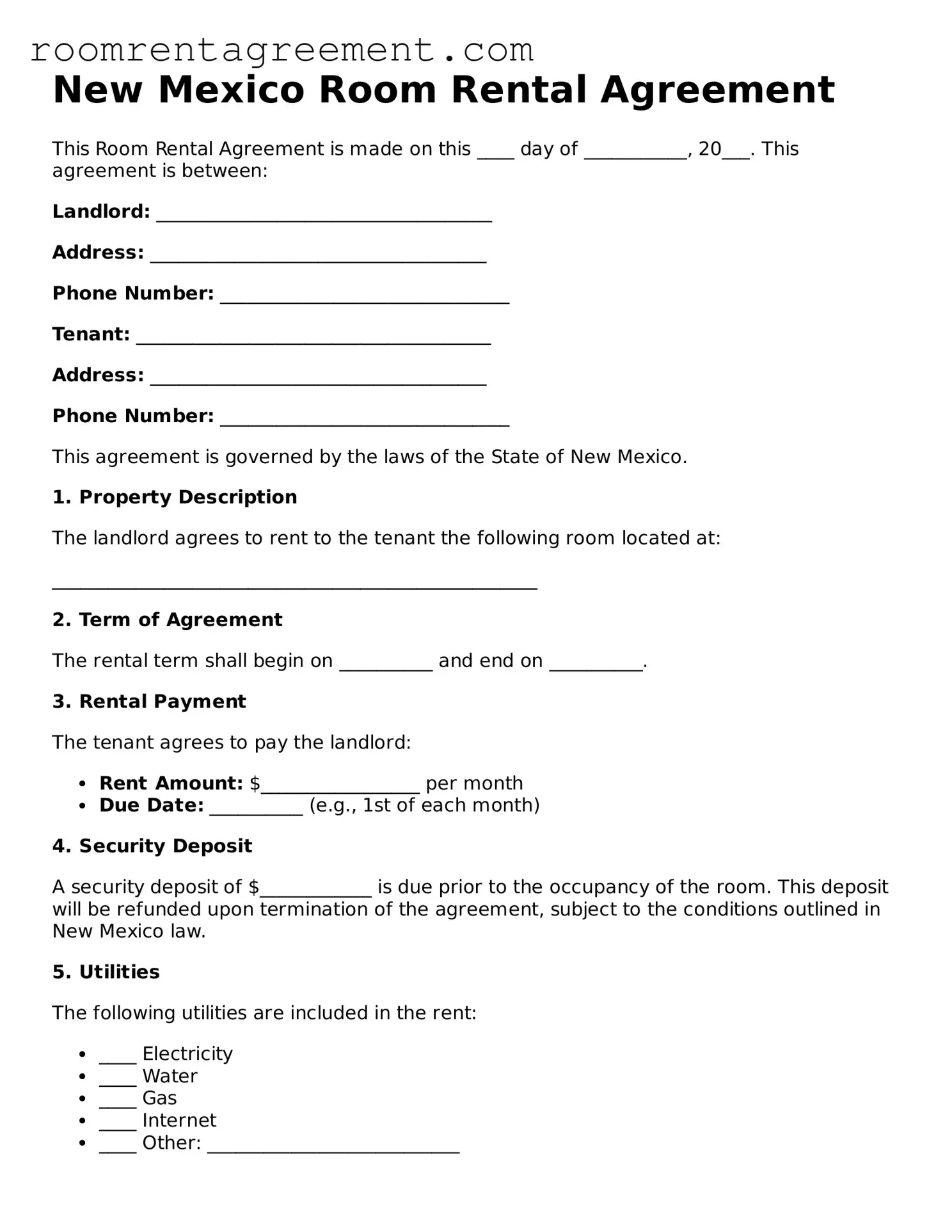The New Mexico Room Rental Agreement form shares similarities with the standard Residential Lease Agreement. Both documents outline the terms under which a tenant can occupy a property, including the duration of the lease, rental amount, and responsibilities of both parties. Typically, these agreements also include provisions regarding security deposits, maintenance obligations, and conditions for terminating the lease. The primary distinction lies in the fact that the Room Rental Agreement is often used for short-term rentals or shared living situations, while the Residential Lease Agreement is generally for longer-term residential arrangements.
Another document akin to the New Mexico Room Rental Agreement is the Sublease Agreement. This form is used when a tenant rents out their leased space to another individual, effectively creating a secondary rental relationship. Similar to the Room Rental Agreement, the Sublease Agreement delineates the terms of occupancy, including rent, duration, and responsibilities. However, it is important to note that the original tenant remains responsible to the landlord, which adds a layer of complexity not typically found in a direct Room Rental Agreement.
The Vacation Rental Agreement is another similar document, particularly relevant in tourist-heavy areas. This agreement governs short-term rentals, often for a few days to a few weeks. Like the Room Rental Agreement, it specifies rental terms, payment schedules, and rules for property use. However, the Vacation Rental Agreement often includes additional clauses addressing issues unique to short stays, such as cleaning fees, check-in and check-out times, and cancellation policies.
The Co-Living Agreement also bears resemblance to the New Mexico Room Rental Agreement. This type of document is designed for shared living spaces where multiple tenants reside together. It outlines the rights and responsibilities of each tenant, including shared expenses, house rules, and the process for resolving disputes. While both agreements facilitate shared living, the Co-Living Agreement places a greater emphasis on communal living dynamics and shared responsibilities.
When navigating the complexities of rental agreements, it's beneficial to refer to comprehensive resources, such as the Business Credit Application form found on TopTemplates.info, which can help businesses understand the credit process essential for facilitating operations within the rental market.
A similar document is the Roommate Agreement, which is often used among individuals who are sharing a rental property. This agreement focuses on the interpersonal aspects of cohabitation, such as how bills will be split, cleaning responsibilities, and guest policies. While the New Mexico Room Rental Agreement centers on the rental terms and legal obligations, the Roommate Agreement prioritizes the relationship between individuals living together.
The Lease Addendum is another document that can be compared to the New Mexico Room Rental Agreement. This addendum is used to modify or add specific terms to an existing lease. While the Room Rental Agreement stands alone, a Lease Addendum often supplements a broader lease agreement. Both documents serve to clarify the expectations of the parties involved, but the Lease Addendum is typically tied to an existing contract.
The Rental Application form is also relevant in this context. While it does not govern the terms of occupancy like the Room Rental Agreement, it serves as a preliminary document that potential tenants complete to express interest in renting a room or property. This application gathers essential information about the applicant, such as employment history and references, which can be crucial for landlords when deciding whom to rent to. Both documents aim to facilitate the rental process, albeit at different stages.
Lastly, the Lease Termination Agreement is similar to the Room Rental Agreement in that it addresses the end of a rental relationship. This document outlines the procedures and responsibilities associated with terminating a lease, including notice periods and conditions for the return of security deposits. While the Room Rental Agreement focuses on the initiation of a rental relationship, the Lease Termination Agreement ensures a smooth conclusion, ensuring both parties understand their rights and obligations as they part ways.
